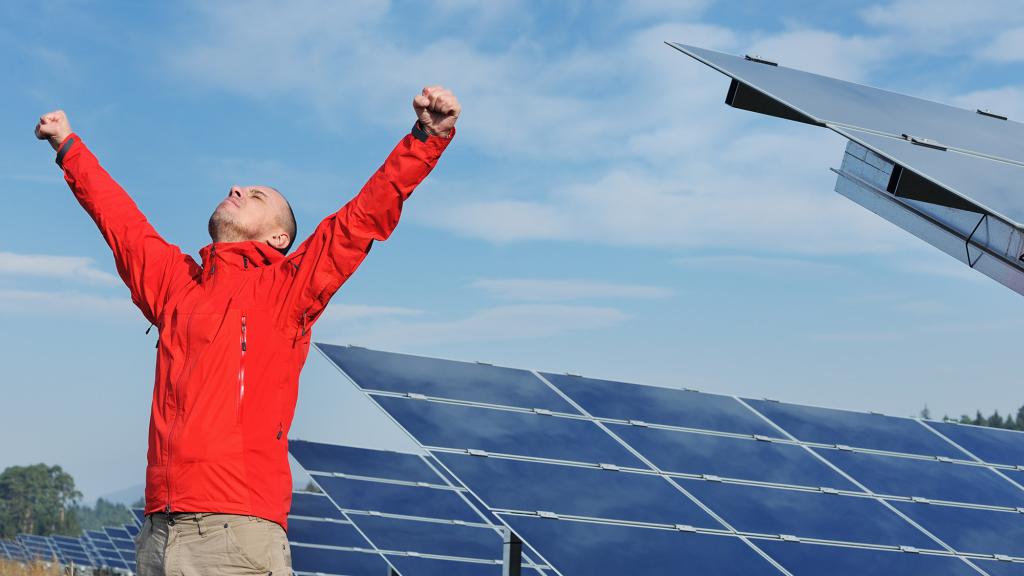Though scientists and environmentalists often feel obligated to hawk the apocalyptic view of the world-to-come, there is a neglected version of the future well worth considering: the one where we win.
British environmentalist Jonathon Porritt is in the optimism business. He’s one of the founding directors of the Forum for the Future, a nonprofit organization dedicated to spreading the gospel of a sustainable future. “I hear good news every day,” he says, which makes us wonder what newspapers he’s reading. But he seems to mean it.
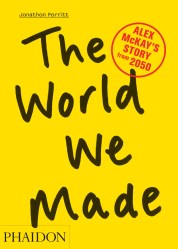 “The backdrop of doom-and-gloom isn’t the whole picture at all,” Porritt affirms. “There’s just so much happening.”
“The backdrop of doom-and-gloom isn’t the whole picture at all,” Porritt affirms. “There’s just so much happening.”
In fact, there’s a lot of room to hope — a point Porritt has set out to prove in his latest book. An imaginary memoir written in the year 2050 by Alex McKay, a teacher in the U.K., The World We Made looks back on the current century from its midway point and explains how we got from the (admittedly dysfunctional) here to the hypothetical there. Key features of this world, fingers crossed, include: an economy almost completely powered by renewable energy; a global population stabilized around 9 billion people; food systems based on community use and closed-loop systems; inefficiency in water management all but eliminated thanks largely to drip irrigation and rainwater capture; comprehensive preventative healthcare with a side of nanotechnology; worldwide sharing economies; and personal jetpacks. (Biofueled and carbon neutral, we assume, but more on those later.)
And, OK, no future’s perfect. Since it’s too late to reverse climate change completely, the sea level will still be rising by the year 2050, weather patterns will continue to flummox and distress, and global inequality won’t be totally quashed. But focusing on the negatives is like tossing the baby and the bathwater out without even reusing the gray water.
All told, Porritt believes we can still manage to build a livable, sustainable, desirable world, one in which economic, environmental, and social advancements dovetail for our collective benefit. Grist sat down for a transatlantic chat with this green futurist (alas, not on a wall-size video screen like the one in McKay’s dreamy kitchen) to see what we might have in store if we play nice.
Q. Can you start by telling us a little bit about this world, which we may get to live in if things go well?
A. I think what’s amazing is that, technologically, it’s going to be possible to create a genuinely good, sustainable world for 9 billion people by 2050. I have absolutely no doubt about that in my own mind whatsoever. That’s a pretty good starting point, because technology is the bare minimum. It’s necessary — without the technology you can’t do it — but it’s not sufficient. You also have to get all the politics in place, the capital markets and financing, and you have to find ways of exciting and mobilizing people so that this becomes a great global priority.
What I’m trying to do in the book is to demonstrate to people that this innovation pipeline is bulging. There are new ideas and brilliant breakthroughs and all sorts of technological opportunities emerging on a daily basis. Which means we can free ourselves from fossil fuels, we can get incredible resource efficiency, we can learn how to manage water far more efficiently than we do now, we can turn waste into raw materials, we can deal with sanitation problems. We need that as a starting point, just to give people a sense of doability — it is doable. At the moment, too many people think it isn’t doable.
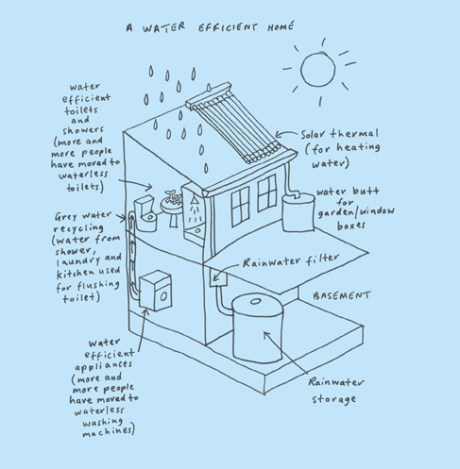
PhaidonAlex McKay’s sketch of a water efficient home gives us real-estate-envy.
Q. Is this book in response to Alan Weisman’s The World Without Us? Here you have a version of the world in which human ingenuity, and not human greed, actually can turn things around.
A. It certainly is. To be honest, it’s a counterpoint to so many things. I joined the Green Party in 1975, so I’ve been in this world for nearly 40 years now. I’ve read so many books that just tell us how grim the situation is, how the problem is human nature, because we’re predisposed to greed and self-interest. I would love to rebut that assumption about human nature. When we have the right kind of political and economic conditions, actually human nature is geared for cooperation. The book is a counter-blast to people who have given up on human beings — and because they’ve given up, they can’t really be bothered to work out the systems we need.
Q. Many of the innovations necessary to this future are interdependent, so that it might be difficult to see how to move from point A to point B. Is there any one technology or innovation that is central to the transition to a truly sustainable future?
A. If you force me to pick one, I’d pick the solar revolution that we’re just in the very early phases of. [Ed. note: Grist agrees.] The most threatening trend we have to combat is accelerating climate change, which could pitch us into irreversible climate chaos. That’s just the biggest nightmare. The way out of that is radical decarbonization, and renewable energy and efficiency are at the heart of that. Of all the renewable energy technologies the one that is just demonstrating incredible breakthroughs — both in cities and rural areas, on-grid, off-grid, embedded, stand alone — with this amazing flow of new technology is solar power.
I’ve just come back from the World Future Energy Summit in Abu Dhabi — which is a crazy place to have an energy summit — but, wow, the kind of breathtaking examples of solar innovation on show there. It’s extremely difficult not to feel upbeat about that.

PhaidonA future forest growing in Qatar, made possible by evaporation-cooled greenhouses, desalinated water, and concentrated solar power to run the whole thing.
Q. I wonder if you’d agree with the metaphor of a “positive feedback loop”? A lot of fears about runaway climate change have to do with destructive feedback loops — melting ice in the Arctic, for example — but your book suggests the alternative, where a little bit of good can reinforce more good.
A. Absolutely. I’m completely persuaded of this. I just know that once people begin to see the difference that these technologies can make in their lives, then they get the bug. They begin to think, “Well, that didn’t look that difficult, it’s not that expensive; in fact, it’s saving me money.”
My favorite story about this is a funny one: In Australia, their ghastly prime minister has basically been hectoring voters for the past three years about how they’ve got to take energy scarcity seriously, and that means they’ve got to invest in coal power. Well, people listened to the message, but then they went off and did something completely different — they started investing in PV arrays on their own roofs. There are more than 1.2 million solar roofs in Australia now. And most people were responding to this sense that energy scarcity might kick in, and that energy supplies would become vulnerable.
So Tony Abbott got exactly the result he probably didn’t want. And, of course, Australia is a brilliant country for solar power. Australia could do everything it wanted on solar power — both PV and concentrated solar power. That’s the kind of example where a little bit of a ripple persuaded a lot of people that this was a very practical thing they could do, and it would begin to make a difference.
Q. You have some unlikely heroes of your own in this book, like a very green China leading the charge on a lot of cleantech innovations. That’s also not a vision of China that many people might recognize. You also talk about organized religions playing a role, along with several other out-of-left-field leaders. How much stock do you put in these groups that other people may be quick to discount? How central are they to making big change?
A. They’re critical. I haven’t written The World We Made for the greenies. I’ve written it for the people who may not come to this with any preconceptions about these things. Take the world’s religions, for instance. There will be a lot of people in the green movement who curl their lips with contempt at the idea that religion has an absolutely fundamental part to play in the transition to a more sustainable world. Look at what lies at the heart of the teaching: It’s all about core sustainability values, about living more simply and respectfully in the face of the natural world. It’s about finding patterns of cooperation rather than simply promoting self-interest. If you want to allow a little bit of optimism into your interpretation of the role of the world’s faith groups, why not go back to the original teaching and suss out the compatibility between that teaching and what we’re all trying to achieve? It’s pretty fundamental.
But I was hoping to provoke a bit. I mean, come on: I didn’t want to make it too pious. I had quite a bit of fun writing the chapter where the American evangelicals lead America into a world where food waste is abolished. Well, okay, that isn’t going to be very probable. But is it logical that it could happen because of the core teaching in evangelical Christianity? It’s perfectly logical. There’s absolutely no reason why that isn’t completely compatible with the tenets of evangelicalism. Is that likely? I don’t know. I think you have to draw some improbable straws out of this jar and see what happens. Give it a whirl sometime, it’s quite fun, you know.
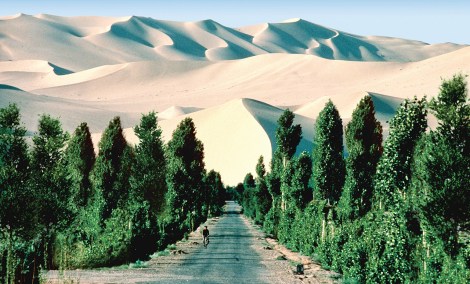
PhaidonEncroaching desert may have to be held at bay by China’s ‘Great Green Wall.’
Q. It’s worth mentioning that The World We Made is not exactly utopian. For example, there are personal jetpacks in the future, but they’re also loud and intrusive so some people are trying to have them banned. That’s not a typical sci-fi future. There is ambivalence about other technologies as well. Could you talk a little bit about some of those tradeoffs?
A. Well, it’s not going to be an easy ride. There will always be risk associated with some of these technologies. One thing I plumped for in the book is the benefit that nanotechnology could bring to a whole host of different technologies. A tiny example: The use of nanoparticles in water purification systems means that you can get the size of the purification unit down to such a small level that you can begin to talk about house-scale water purification systems — at incredibly low cost, anywhere in the world.
I’ve looked at all of this nano stuff and yes, there are clearly some worries and dangers. But I think the upside warrants more determination to use technology like that in the right way. I know there will be a lot of people in the green movement who won’t respond to that, because we’ve got used to thinking that risk trumps opportunity in many of these technologies. I think you just have to say that if you really did this right and you regulated properly and you made sure the rollout programs were done in the interest of humankind at large — I know, those are big “if”s — then you’ve got an upside that is so amazing that you probably want to go for it.
Q. If I could quibble over one particular point with you: You talk about geoengineering in one chapter, where you do discount some schemes, like solar radiation deflection, while others like ocean fertilization you seem more optimistic about. How much can we manage the risks that go along with these opportunities?

PhaidonThat tall building is completely water neutral in this futuristic Kuala Lumpur.
A. That section was really difficult to write, I have to be honest. I absolutely hate the idea that we’re going to have to end up doing large-scale geoengineering, in order to suck huge amounts of CO2 back out of the atmosphere. But when you crunch the numbers and you look at what we’ve already put up there, no mathematical account of this gets us to that point of safety without some engagement on geoengineering.
I have tried to be very realistic about using the data we have available to us today. That chapter isn’t written out of any sense of personal excitement about a geoengineering future. It’s written from the recognition that we’ve got things so badly wrong so far that we’re almost certainly going to have to do it — and at huge cost.
Not everything in the book is something I believe in. In the agricultural chapter, there’s a part about genetically modifying wheat and rice to allow for nitrogen fixation in the roots of these crops. That isn’t something I personally feel is the right way to go, in terms of resource management and crop systems, but I’ve tried to say, “Look, this is going to be an interesting world.” Not everybody is going to agree with every bit of it, myself included.
Q. One of the particularly striking examples of change is the shift from profit- and growth-driven business to cooperatives and larger-scale sharing economies. How is that change, which seems enormous and totally crucial, how is that going to happen?
A. The book I wrote before this is called Capitalism As If The World Matters, in which I asked myself whether sustainability and capitalism are mutually compatible — could capitalism ever deliver a just, fair, genuinely sustainable world? And I came to the conclusion: Probably not.
I fundamentally believe we can still have an economy that is based on the market, which still relies on profitable enterprise, that still provides for private ownership. Those are three of the core tenets of capitalism: markets, profit, and private ownership. I still believe it’s possible to have those as central characteristics, but you can’t do that without challenging the grotesque inequality in the world today, and the behaviors of multinational companies today in the pursuit of profit.
That’s where you begin to look at the alternatives. The B corporations, for instance, which I’ve projected a massive growth in, cooperatives, collaborative patterns of wealth creation at the local level. All of these things are still market-based forms of wealth creation. And they’re all there. The co-op movement is a vast global movement already today. It’s just that we have to get better at using all of that, and learning how to prosper through it.
Q. OK, I could see that.
A. There isn’t what I would call structural resistance to the idea. Wealth creators love the business of creating wealth, whether it’s the red-in-tooth-and-claw form of predatory capitalism we have now, or a completely different version, one that allows us to promote community interests and justice and environmental sustainability even as we pursue prosperity through profit. It only sounds unlikely because a tiny, tiny minority of the world’s hyper-rich tell us that nobody could manage the world economy on that basis.
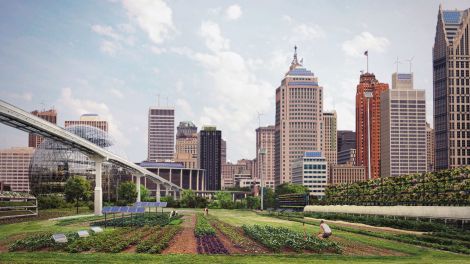
PhaidonIn 2050, Detroit is a revitalized city characterized by uber-productive urban farms.
Q. You make a point of saying that we could have these things now, and it’s hard not to come away feeling a little frustrated or wistful that we don’t. Is there any one thing that you feel especially frustrated that you can’t have right now? Any favorite feature?
A. I do feel particularly wistful about two things. One is education. The opportunity to bring young people up with a different sense of our relationship to the natural world, and their responsibility to themselves and their communities — that is so amazing. I was a teacher for ten years, and I still think that education is one of the most powerful potential sources of radical transformation. There are a ton of things happening in the world of education that encourage hope in that respect. So I feel sad that we haven’t got that universally spread throughout education, across the entire planet.
The second thing is the disconnection between us and the food that we eat. We seem to have got ourselves into a very bad place when it comes to our understanding of the importance of food, how it gets onto our plates, our relationship with the animals that we consume so thoughtlessly, and our relationship with the land that we pay no attention to at all. There are many, many people in our world who believe that that relationship between land-food-farming-health is absolutely at the heart of what a sustainable world has to mean.
Q. Of the total solution as you see it, how much is technology-based — how to “build a better lightbulb,” so to speak — and how much is learning to leave the lights off more often?
A. I think that’s the nub of it, really. It’s very clear that there will have to be significant changes in our lifestyle: the way we seek to improve our own lives, how we can live more collaboratively and less materialistically, with far higher levels of political engagement. I really have gone to great lengths to say, “Please don’t fall into the trap of thinking that technology does everything for us.” It doesn’t. It gives us the permission to do everything we need to do.
I know that’s a complicated balancing act, and I know some people would go straight to the technology and say, “Oh, OK, so we’re going to be alright.” No. Technology creates the foundation out of which we can build this better world, but it won’t do it without profound change in every other aspect of our lives.
